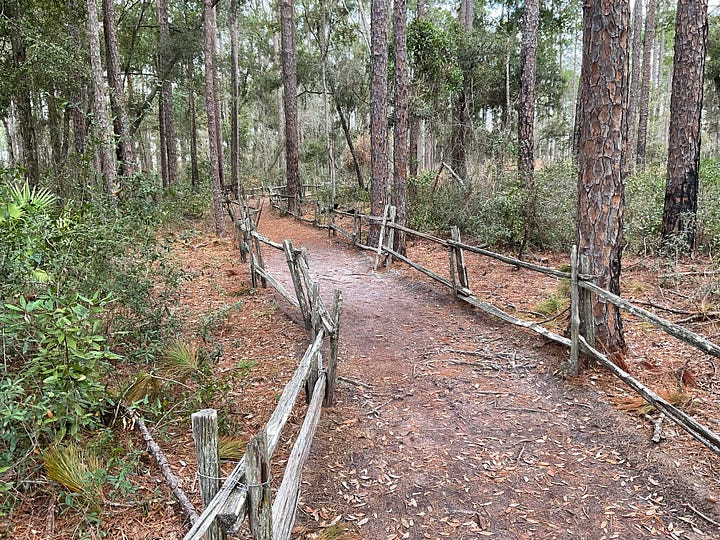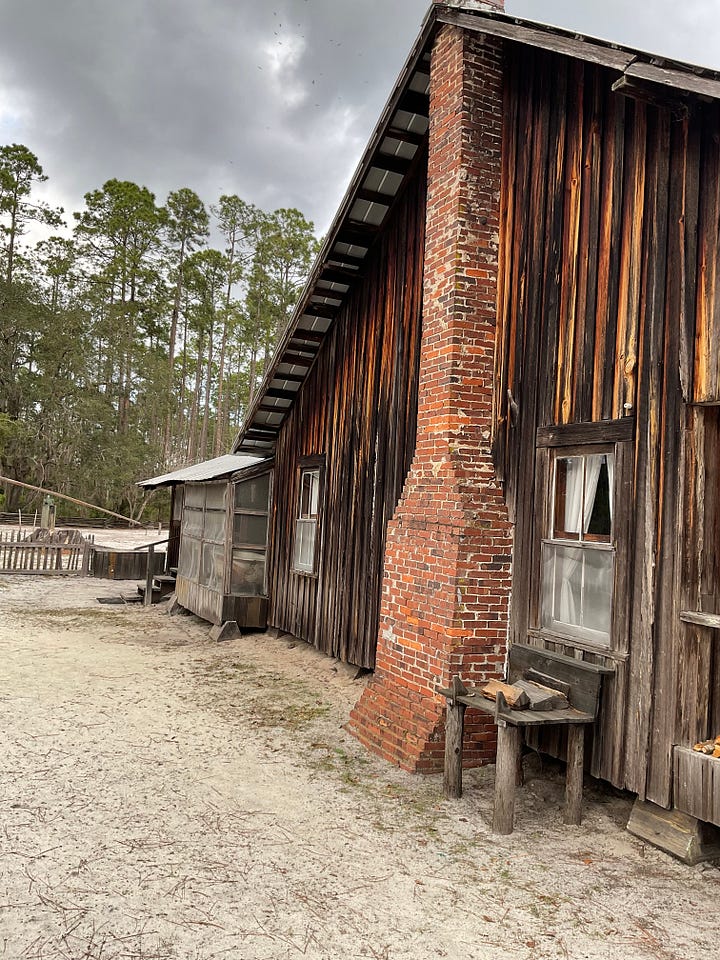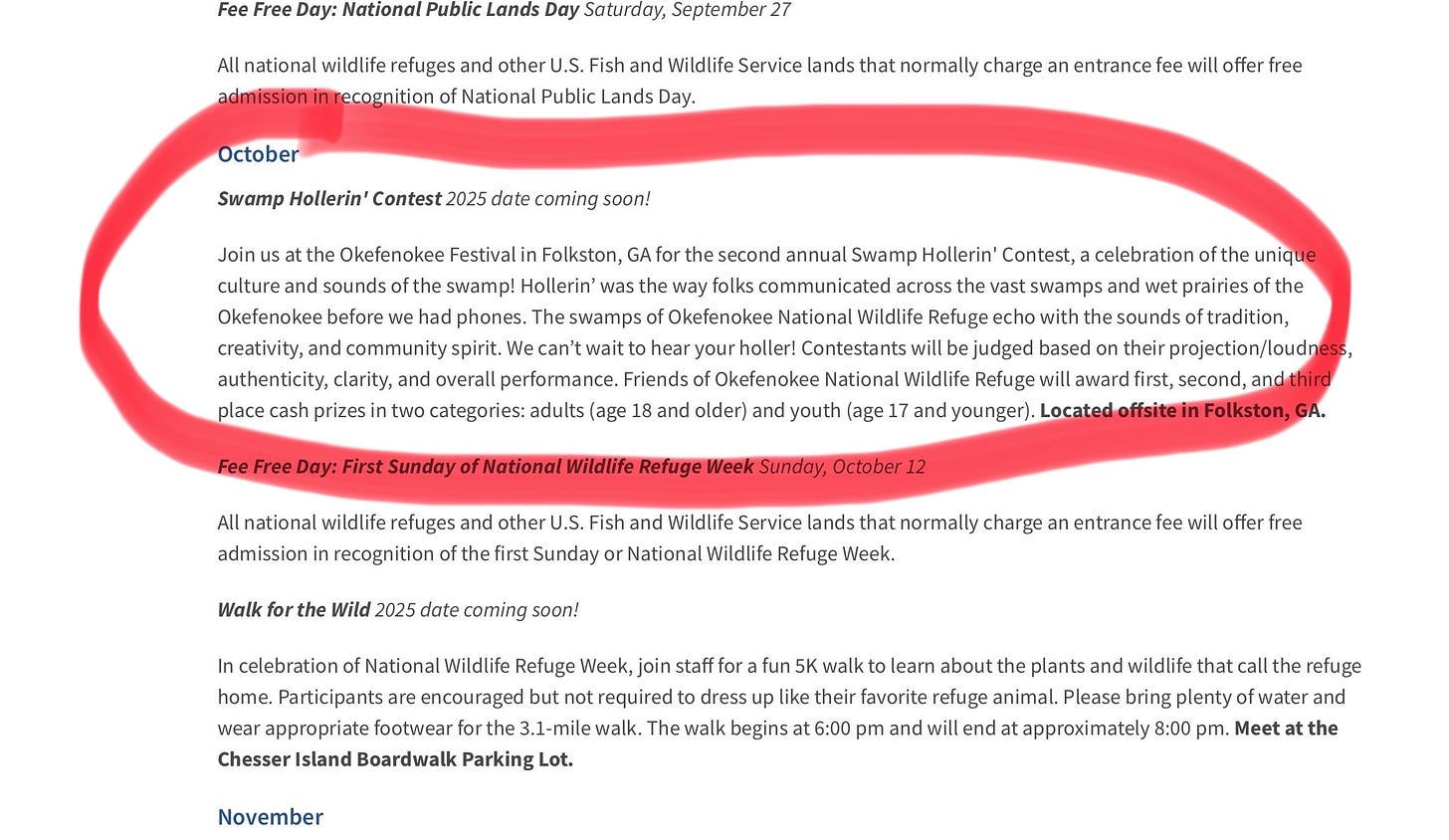Swamp Hollerin’
In a time before texting, cell phones or even electricity, hollerin' was the way these folks communicated.
On the green map you see blue patches that look like spiders and have names like “Sometime Hole”, “Blackjack Lake”, “Maul Hammock Lake” and “Perch Lake”. I wonder why such funny names and exclaim “wow this is bigger than I thought”.
The Okefenokee National Wildlife Refuge is a 402,000 acre National Wildlife Refuge located in three counties in Georgia, and one county in Florida. It is vast expanses of unusual beauty. The refuge was established in 1937 to protect a majority of the 438,000 acre Okefenokee Swamp. It is the is the headwaters of the Suwannee and St. Marys rivers.
Though often translated as "land of trembling earth", the name "Okefenokee" is likely derived from Hitchiti oki fanôːki "bubbling water". Hitchiti is part of the Miccosukee Indian Language which is a Muskogean language of the American Southeast. It is still spoken today by about 500 Seminole people in Florida. (Through my reading at the museum).
We visited Okeefenokee National Park in Georgia in mid-February 2025.
Part of the driving tour was a stop at a remote homestead, while much of the homestead may seem strange to city-folk, it was very similar to the log cabin life we’re currently living.
We were game to stop.
The Chesser family claimed an island inside the Okefenokee Swamp in the 1850s and built their home. There were several iterations of the homestead but the existing cabin was built in 1929 for $200.
The cabin you can tour includes the furnished house, a syrup shed, smokehouse, grindstone, hog pen, chicken yard and coop and corn crib. We were lucky to be there when a volunteer was there so the house was open, in fact she was the granddaughter of one of the original Chessers and boy was she interesting.




It was a historic place where we learned a great deal about typical pioneer life in the great Okefenokee Swamp. Look closely at the bottom right photo, on the screen porch is a claw-foot bath tub. This was considered hi-flautin’ in the day. Pioneer living in the swamp was very different from what we know about pioneer living in the Midwest.
🪵There were ruthless and abundant mosquitoes which were conquered (somewhat) with purple martin gourd houses.
🪵There is no grass or lawn around the house to prevent accidental fires from happening. That’s white sand, not snow surrounding the cabin.
🪵Cypress, because of its durability, was used liberally by swampers in construction projects. Its use as a hollowed log in a well was quite necessary since the wood is fine being continuously wet. Without the hollowed log, freshly dug wells would cave in and refill with the sandy soil that is so common adjacent to the swamp.
🪵Even beekeeping was different. The Okefenokee area is well-known for its fine quality gallberry honey. Gallberry is an evergreen shrub found in bogs and moist wetlands. Gallberry honey is a unique honey that is slow to crystallize because of its high pollen and enzyme content. Swamp families, dependent upon honey as a sweetener, frequently established homemade beehives in hollow cypress logs. A hole was notched near the base for access by the bees. Nectar gathered from swamp flowers made honey production excellent and the supply quite plentiful.
🪵But the most interesting feature about this homestead was the naval store operation locally referred to as "turpentining". Naval stores are a nearly forgotten legacy in the South, but throughout history nations have depended on them, sought them out, and fought wars over these coniferous products. These products: tar, pitch, turpentine, and rosin long kept the wooden navies of the world afloat and found many other uses prior to petroleum products. Turpentining helped support swampers and much of the South’s economy for nearly 400 years.
But in getting back to the funny names for the lakes I mentioned earlier, I found that swampers had their own language and ways of communicating and this was the most interesting part of our swamp outing.
It was the following bit of culture in the online park brochure that sent me down this path of discovery, and who wouldn’t go with a description like this:
Swamp Hollerin’
For periods in its history, the Okefenokee Swamp was a refuge for Indian people, fugitives from slavery, deserters during the Civil War and others seeking concealment.
The swamp also became home to an independent, self-sufficient community, most of whom came to Georgia from North Carolina and were of Scottish and Scots-Irish origin. They scratched out a living through survival livestock herding and survival agriculture, and naval stores.
In a time before texting, cell phones or even electricity, hollerin' was the way these folks communicated. Swamp hollering is a vocal tradition practiced in the Okefenokee Swamp, where it was used as a form of communication between individuals. Swamp folk had recognizable hollers that could mean things like "I’m almost home" or "You can quit your worry".
Most hollers can be broken down into four different categories. There are communicative hollers, which could be as simple as a “hello” to a far-off neighbor; distress hollers, which are used to signal the need for help; functional hollers, which might indicate farm work, or a need for supplies; and expressive hollers, which is hollerin’ just for the fun of it.
And each person’s holler is different. Everybody created their own sounds and these hollers were sort of a signature for the person who did them.
The tradition of hollering in the Okefenokee Swamp is an important part of its cultural heritage.
Swamp Hollerin’ on the National Stage
Swamp hollerin’ isn’t unique to the Okefenokee Swamp, it was common in other parts of the South as well. Specifically it was one of the ways farmers in Sampson County, North Carolina, got messages to each other from a distance.
What’s so special about Sampson County?
It’s home to Spivey's Corner, North Carolina and for nearly 50 years, the town kept the tradition alive with the National Hollerin' Contest.
What’s the National Hollerin’ Contest?
In 1959, a church in the county burned down, devastating the community. That event spurred them to launch a volunteer-led fire department in Spivey’s Corner. But in order to raise money for the fire department, they needed an event that could bring people together. That’s when someone had the idea to revive the tradition of hollerin’.
The event went from 500 to over 10,000 in attendance over the years.
Soon, media outlets from around the world began to take notice, including Johnny Carson, who, for a number of years, would invite the winners of the National Hollerin’ Contest on the Tonight Show, the Late Show with David Letterman and Good Morning America. And, in the early ’70s, the contest was broadcast over Voice of America.
For almost 50 years the National Hollerin’ contest was kept alive while they tried to get others involved. A lot of what the contest was about focused on educating and even though hollerin’ was no longer used, it was important to try to keep those traditions going. They eventually decided they didn’t want people making a joke of it and looked at ending the contest. Hollerin’ is part of Southern heritage and they hoped they could keep the contest going but rather than string it out they decided to end the contest.
National Hollerin’ Contest ceased to exist in 2015.
Interested in what Hollerin’ sounds like?
Are you ready to compete in the October Swamp Hollerin’ Contest at Okefenokee?
Know someone who would enjoy reading this? Feel free share it with them…










Fascinating. This is all new to me! It is amazing how people managed to survive in wild terrain.